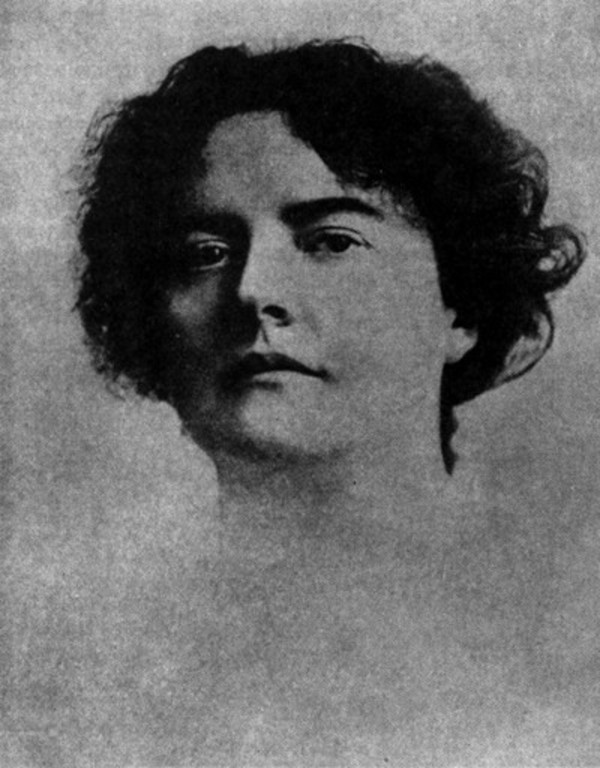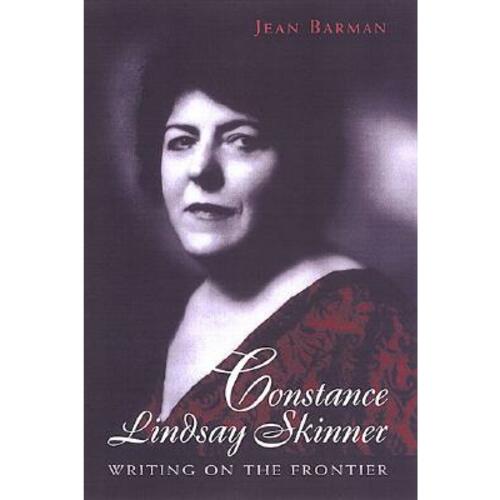
Source: Link
SKINNER, CONSTANCE LINDSAY (named Constance Annie), author, journalist, and editor; b. 7 Dec. 1877 in Stanley, B.C., only child of Robert James Skinner, clerk of the HBC trading post at nearby Quesnel, and Annie Lindsay, a former teacher; d. unmarried 27 March 1939 in New York City.
Although she spent almost all of her working life in the United States, Constance Lindsay Skinner, by virtue of her ancestry and early upbringing, was as deeply embedded in British Columbia as any non-aboriginal person could be. Her paternal grandfather, Thomas James Skinner, was one of three men recruited from the English gentry in 1852 by a Hudson’s Bay Company subsidiary, the Puget’s Sound Agricultural Company, to manage its large farms in the British colony of Vancouver Island. Her maternal grandfather, Daniel Lindsay, was a Scot enticed to the colony by the gold rush of 1858; he ran a general store in Victoria. In 1887, when Skinner was ten, her parents left the Cariboo region for Victoria and then Vancouver, where she attended a private school. From her mid teens onwards, she composed music and wrote plays, poetry, and newspaper articles, often under different pseudonyms such as C. Lindsay Skinner and Constant Lindsay, perhaps to avoid being dismissed because of her gender. In 1895 she published a travel feature on the British Columbia interior in the leading Canadian Magazine (Toronto) under the name Constance Lindsay. In 1913 she would begin to sign her poetry Constance Lindsay Skinner and by 1920 she would use that name for everything she wrote.
By the time she entered her twenties Skinner was determined to have a writing life and considered herself stifled in Vancouver, still a small town. She turned down an invitation to spend some time in Toronto and instead headed to Los Angeles in 1900; her choice was indicative of British Columbia’s isolation from the rest of Canada. She talked her way into a job as drama and music critic for the Los Angeles Times. By mid 1901 her articles were being reprinted in papers throughout the United States. In 1903 she moved to the Los Angeles Examiner, owned by William Randolph Hearst. As well as being a critic, she was one of the early sob sisters, women journalists who wrote human-interest stories. She was particularly effective in her use of interviews with celebrities to disclose their innermost secrets. She followed her newspaper editor, Arthur L. Clarke, to Chicago in 1908 and worked there as a drama critic. In 1912 she went to New York City, where she would support herself by writing until her death in 1939.
Moving between literary genres in response to economic opportunities, Skinner gained credibility in all of them. One of the plays she wrote while still in Los Angeles, a biblical drama, David, had inaugurated the outdoor Forest Theater in the artists’ colony of Carmel, Calif., on 9 July 1910; a contemporary drama probing the boundaries of interracial sexuality on the northern coast of British Columbia, The birthright, played in the Shubert brothers’ theatres in Chicago in 1911 and Boston in 1912; and a light-hearted play about a rich young Anglo-Quebec widow finding love again, Good morning, Rosamond!, opened in one of the Shuberts’ New York City theatres in 1917.
Skinner’s poetry was widely published and won several prestigious awards. Her innovative verse, written from the perspective of aboriginal men and women, was included in George William Cronyn’s frequently reprinted The path on the rainbow: an anthology of songs and chants from the Indians of North America (New York, 1918) and a collection of her poems was published as Songs of the coast dwellers (New York, 1930) by Coward-McCann Publishing Company.
In 1918 Skinner had accepted an invitation from Robert Pollock Glasgow* to write popular history for Yale University Press’s monograph series Chronicles of America; most of the other authors he approached were academics and few were women. For the series she produced Pioneers of the old southwest: a chronicle of the dark and bloody ground (New Haven, Conn., 1919), about the Kentucky–Tennessee frontier at the time of woodsman Daniel Boone, and Adventurers of Oregon: a chronicle of the fur trade (New Haven, 1920), about the Pacific northwest. Her editorial work on historian Herbert Eugene Bolton’s highly influential Spanish borderlands: a chronicle of old Florida and the southwest (New Haven, 1921), in the same collection, was so extensive that she could be said to have been his ghostwriter. Other works included Adventurers in the wilderness (New Haven, 1925) for Yale University Press, which she co-authored with anthropologist Clark Wissler and historian William Charles Henry Wood*, and a history of the fur trade entitled Beaver, kings and cabins (1933), published by the Macmillan Company of New York. In 1934 she persuaded the up-and-coming New York publishing firm of Farrar and Rinehart to hire her as editor of Rivers of America, which she developed as a successor to Chronicles of America. Before her death six volumes would be issued in what would become a widely acclaimed monographic series, reprinted into the early 21st century.
Economic concerns had led Skinner to turn to other genres. By 1922 at least 25 short stories had appeared in popular magazines. Mostly with Macmillan, she published ten young people’s adventures between 1925 and 1934 and she would be lauded by literary historians as one of the first writers to have girls as protagonists. Never abandoning journalism, she was almost from its beginning in 1924 a regular reviewer for Books, the New York Herald Tribune’s weekly publication, and she wrote numerous short features for adult and young people’s magazines. She used these genres as she did others, to probe the meaning of frontiers or boundaries in people’s lives. For Skinner the frontier could be a literal place, an unexplored country where people were willing to brave the unknown, but it could also be boundaries imposed by gender, sexuality, and race that could or could not be crossed.
Skinner was least successful artistically as a novelist. Her novels had Canadian settings which worked against them in the United States even as they were ignored in Canada. Good-morning, Rosamond! (New York, 1917) echoed the play of the same name, The search relentless (London, 1925) was based on her father’s fur-trade adventures, and Red willows (New York, 1929) recounted the story of the Cariboo gold rush. Her other novel, The white leader (New York, 1926), was set on the Kentucky–Tennessee frontier, which she had researched for Pioneers of the old southwest and had used for some of her juvenile literature.
During her lifetime Skinner published 19 books which she authored and 6 which she edited, upwards of 30 short stories, at least 75 poems, and countless articles and book, theatre, and music reviews. She also maintained a pithy correspondence with, among others, critic William Arthur Deacon*, dramatist Herbert Heron, artist Wilfred Langdon Kihn, film actor Chief Buffalo Child Long Lance [Sylvester Clark Long], authors Jack London and Madge Macbeth Lyons*], arctic explorer Vilhjalmur Stefansson*, and historian Frederick Jackson Turner. In her fiction she often used incidents from her Canadian upbringing, either explicitly or refashioned into a comparable American setting. While accepted into the American literary canon, she poses a dilemma for Canadian scholars. In part because she never worked in Toronto, long Canada’s literary centre, she has been more ignored than acknowledged as being among the numerous Canadian writers who perforce left, but did not abandon, the country of their birth in order to make a living by writing.
Skinner was exceptional for her time in her determination to push at frontiers both as a woman and as a writer. Most of the female authors with whom she corresponded had a husband or other means of support, whereas she rejected marriage and other options in favour of living by her work alone. The frontiers she explored were also examined in the writings of some of her contemporaries, but, unlike these mostly male authors, she presented contentious characters such as girls who were as brave and resourceful as their brothers, women who refused to defer to men simply because they were men, aboriginals who had rich emotional lives, and sexual partners of different races. She lived and died her own woman.
The information provided above is expanded upon and documented in three publications by the author, Jean Barman: Constance Lindsay Skinner: writing on the frontier (Toronto, 2002), which includes a chronology of her life and a list of her publications; “‘Vancouver’s first playwright’: Constance Lindsay Skinner and The birthright,” BC Studies (Vancouver), no.137 (spring 2003): 47–62; and the “Introduction” to Skinner’s play Birthright (Toronto, 2005). Also useful for information on Skinner are American national biog. (Garraty and Carnes), 20: 67–69, and D. M. A. Relke, Greenwor(l)ds: ecocritical readings of Canadian women’s poetry (Calgary, 1999). Skinner’s papers are in the mss and Arch. Div. of the New York Public Library, Humanities and Social Sciences Library. The finding aid (including an index of correspondents) can be consulted at www.nypl.org/sites/default/files/archivalcollections/pdf/skinner.pdf. Skinner’s correspondence survives in numerous literary collections, including the Herbert Heron papers in the Henry Meade Williams Local Hist. Dept. of the Harrison Memorial Library (Carmel-by-the-Sea, Calif.), the W. Langdon Kihn papers in the Smithsonian Instit., Arch. of American Art (Washington, D.C.), the Madge Macbeth fonds in LAC (R2057-0-2), the Vilhjalmur Stefansson corr. in the Stefansson Coll. at Dartmouth College Library, Rauner Special Coll. Library (Hanover, N.H.), and in the National Arch. and Records Administration (Washington), XESN, Evelyn Stefansson Nef family papers.
Cite This Article
Jean Barman, “SKINNER, CONSTANCE LINDSAY (Constance Annie),” in Dictionary of Canadian Biography, vol. 16, University of Toronto/Université Laval, 2003–, accessed December 31, 2025, https://www.biographi.ca/en/bio/skinner_constance_lindsay_16E.html.
The citation above shows the format for footnotes and endnotes according to the Chicago manual of style (16th edition). Information to be used in other citation formats:
| Permalink: | https://www.biographi.ca/en/bio/skinner_constance_lindsay_16E.html |
| Author of Article: | Jean Barman |
| Title of Article: | SKINNER, CONSTANCE LINDSAY (Constance Annie) |
| Publication Name: | Dictionary of Canadian Biography, vol. 16 |
| Publisher: | University of Toronto/Université Laval |
| Year of publication: | 2013 |
| Year of revision: | 2013 |
| Access Date: | December 31, 2025 |




